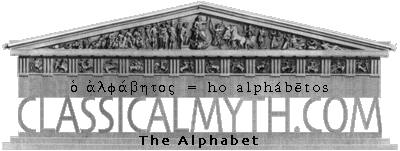


These pages are meant not for students of Greek, but for my myth students and others interested in learning how the Greek alphabet relates to English renderings of Greek words and terms. If you're a student beginning the study of the Greek language, try looking here for some links that will help you track down materials more suited for your pursuits. Note: this page uses the Symbol font to display some Greek. About 95% of the computers in the world have it. If yours doesn't, why not? Join the unwashed masses! There's nothing like glorious conformity.
You can quiz yourself on the names of the Greek letters here.
"Transliteration" is the conversion of words written in one writing system into another writing system. "Basic" (or "direct") transliteration is a simple system to convert the Greek alphabet into our own. Once you know the names of the letters, this system is incredibly easy since the names of each letter begin with the letter(s) we use to transliterate. Those values are shown above as the black characters in the letter names. So the first letter is Alpha (= a in basic transliteration), the second Beta (= b), the third Gamma (= g) and so on all the way down to Chi (= ch), Psi (= ps) and Omega (= ô).
So if we take the Greek name ZeuV, we see it's written zeta-epsilon-upsilon-sigma. In basic transliteration, therefore, ZeuV is Zeus. Easy.
ArtemiV = alpha-rho-tau-epsilon-mu-iota-sigma = Artemis.
Poseidwn = pi-omicron-sigma-epsilon-iota-delta-ômega-nu = Poseidôn.
DionusoV = delta-iota-omicron-nu-upsilon-sigma-omicron-sigma = Dionysos.
Artemis and Dionysos show two of only four issues in this system--and they aren't all that difficult.
This one involves the letter rho, which always has the value RH at the beginning of words (which is an easy way to spot Greek words in English...RHinoceros, RHythm, etc.) but just R in other places, except after another R and in cases where two words have been put together into one word (a compound word). So Kallirhoê has the RH because it's really kalli + rhoê (beauty + flow = beautiful-flow, the name of a water nymph).
Another difficulty is with the letter upsilon, which, if it comes after another vowel, is U as you would expect, but if it's in between two consonants, it is usually transliterated as Y. So Yuch = Psychê, but ZeuV = Zeus. In some books you'll see they don't bother with this and just use U in all places. In those books Yuch = Psuchê.
The Greeks used the letter gamma before another gamma, a kappa or a chi to represent the -ng- sound. So our word angel comes from the Greek aggeloV. In these cases the first gamma will be transliterated as N.
The standard Greek alphabet doesn't include a separate letter for the H sound, even though many dialects of Greek had the sound. Instead two small marks called "breathing marks" are used. One, the so-called "smooth breathing" means nothing and it's a bit silly, really. It looks like an apostrophe before a capital vowel or over a lower case vowel. The other, the so-called "rough breathing," which looks like a reverse apostrophe (the open side faces to the right), means that the word starts with an H sound and should be transliterated with an initial H. The classical Greeks themselves didn't use these marks because they grew up knowing which words started with H and which didn't. One strange thing: All words beginning with upsilon in Greek have the rough breathing. So you'll see lots of names starting with HY, like Hyacinthus and Hylas.This also makes spotting Greek words in English easier (think hypochondriac, hyperactive, hydraulic, hypnosis, hysterectomy, etc.). The Symbol font doesn't include the resources for showing rough and smooth breathings. I'll get some images up soon to show them. But for now if you look up at the graphic at the top of this page, you'll see that alfabhtoV is written with a smooth breathing (= alphabêtos, no H) but the little word o ("the") is written with a rough breathing and so it is transliterated with an H (= ho).
If you're ready to try transliterating letters (changing Greek letters into English ones), go ahead and practice here.
So why do Greek words and names sometimes look so very different in different books? The answer is that the more familiar names and terms from Greek were usually borrowed into English via Latin and not taken directly. The Romans used the direct ancestor of our alphabet, which was in turn borrowed from the Greeks but was not identical with the Greek alphabet. One result of this is that the Latinized forms all show C where direct transliteration shows a K. So our water nymph Kallirhoê up above will also show up as Callirhoê. Similar shifts mean that OU shows up as U in Latinized words, AI as AE, OI as OE, and so on.
More troublesome are the various changes that the Romans made when naturalizing Greek names into Latin. Sometimes these make a name look quite different. AiaV becomes Ajax, for example (direct transliteration would have Aias). Sometimes further changes then happened in English and things become really messy. OdusseuV became Ulixes in Latin, then Ulysses in English! But these really wacky things only occurred with pretty common names. For the most part, the process of Latinizing & then Englishizing (I can use that word if I want to) is pretty predictable, just not something we want to get into right now. And often, as with Odysseus, English speakers have started to use a form derived directly from the Greek in place of a Latin-derived version (like Ulysses) that used to be more common.
Copyright and disclaimer © 2002, Stephen M. Trzaskoma